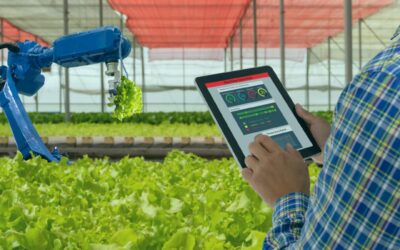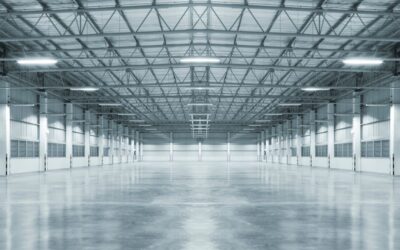Publication Profile – Case Study
The following is an excerpt of a book chapter by Dr. Eric W. Stein on the Digital Transformation of Agriculture. This excerpt features a case study of Zordi, Inc. , which is a greenhouse farm in New Jersey that uses robots and artificial intelligence (AI) to assist in growing strawberries.
Citation
Source: Stein, Eric W. “The Digital Transformation of Agriculture: Industry 4.0 Advances in Hydroponic Vertical Farms and Greenhouses.” Book chapter to appear in: Digital Transformation and Society. Edited by Dr. Jay Liebowitz. World Scientific. 2024 (in production).
Abstract
This book chapter explores the profound impact digital technologies have had on farming by revolutionizing agricultural practices and fostering more sustainable and efficient food production. We look at the integration of cutting-edge technologies, data analytics, and smart systems to optimize resource utilization, enhance crop yields, and address the challenges of contemporary agriculture. We have narrowed the scope of this research to examine a relatively new type of farming; i.e., indoor farming, which includes modern greenhouses and vertical farms. Indoor farming was made possible by advances in LED lighting, irrigation methods (e.g., hydroponics), facility environmental controls (Stein 2021), and advanced digital technologies aligned with Industry 4.0. The chapter includes a case study of a greenhouse farm (Zordi) that grows strawberries using robotics and artificial intelligence (AI).
Acknowledgements
The author wishes to thank the following people and organizations for their support and contributions to this work: Dr. Gilwoo Lee, CEO of Zordi, Inc.; Neda Vaseghi (CEO) and Loren West (CTO) of Microclimates, Inc.; Sepehr Archard, CEO of iGrow News and Suzanne Pruit, Events Director at Indoor Ag-Con.
Keywords
digital transformation, agriculture, farming, vertical farming, greenhouse farm, hydroponics IoT, artificial intelligence, machine learning, robots, industry 4.0, agriculture 4.0
About the Author
Dr. Eric W. Stein is the Executive Director of the Center of Excellence for Indoor Agriculture and Associate Professor of Management Science and Information Systems at Penn State.
________________________________________________________________________________________
Case Study Excerpt
….To address the challenge of lowering labor costs while maintaining quality, one indoor farm start-up, Zordi, is leveraging advanced digital technologies including robots and AI analytics to grow strawberries in relatively low-cost greenhouses (See Figure 5.1). The company was founded by Dr. Gilwoo Lee, a graduate of MIT, Carnegie Mellon and the University of Washington in computer science, robotics and AI. According to Lee, Zordi’s mission is to “feed the world with high-quality, sustainable food.” The company has received $20M in venture funding (Hortidaily 2023). At the time of writing, the price of a ½ lb package of Zordi strawberries was $18 at a retail partner in New York City. Although the company is still in start-up mode and doing R&D, according to the company’s estimates, each farm high tunnel is expected to yield gross profits of 50-60% with a projected capital payback of approximately three years. According to Lee, these projections are based on selling strawberries directly to retail grocery stores in major metro areas at competitive prices at scale.

Figure 5.1: Scouting Robot Collecting Visual Data on Strawberries in Greenhouse
Source: Image courtesy of Zordi, Inc.
Zordi’s R&D farm is located in Oakfield, NY near Buffalo and features several inter-connected gabled medium technology greenhouses designed to test sensors, robots and its analytic models. Its second farm, which is designed for commercial production using high tunnel greenhouses, is located in Vineland, NJ on the site of a former farm. High tunnels (or hoop houses) are relatively inexpensive structures that are built using galvanized metal piping bent in a semi-circle. Transparent plastic poly film is used to clad the structure, which protects the plants from cold, wind, rain and snow while still admitting sufficient light for the plants. Greenhouses typically require lower energy costs than indoor vertical farms, although heating with natural gas or propane may be required in northern latitudes and cooling may be necessary in warmer climates. Zordi has chosen to invest in robotics and AI (as opposed to the building structure itself) to reduce labor costs associated with the plant and operations systems, while enabling high yield and quality at scale (See Table 5.1). At the time of this writing, energy, lighting, and other components of cost are not linked to the AI analytic model but could be at a future date. The long-term goal is presumably to lower the total cost of goods sold (COGS) sufficiently to enable the firm to increase gross margins and/or to expand market share by lowering prices.
The company’s approach to digital transformation is grounded in the idea of a central “AI farm manager” making decisions based on data it receives from stationary IoT sensors and roving robots (See Figure 5.2).

Figure 5.2: Illustration of Smart Greenhouse
In this architecture, three types of robots perform functions that closely resemble line production workers whereas the AI farm manager serves to augment or replace skilled labor and horticultural specialists at the production facility. The harvesting robots do plant maintenance activities such as pruning, cutting, harvesting, as well as sorting and packing of the fresh produce based on the maturity of the plants (See Figure 5.3). The scouting robots traverse the aisles between plants and collect data on the visual appearance of the plants, the presence of insects and other parameters related to plant health and the environment (See Figure 5.1). These data are relayed to the central AI farm manager, which houses the processing, BD database and models. The AI farm manager parses the data and uses analytical models to process the information into tasks. For example, it might use pattern matching, machine learning, and other AI techniques to detect disease, nutrient deficiencies, and other plant anomalies, leading to specific actions that need to be taken. For example, an outbreak of predatory insects might trigger the need for a foliar spray at specific locations. A 3rd-party robot customized to Zordi’s specifications will then administer foliar sprays when needed. In summary, the AI farm manager monitors the farm over time and generates work orders to optimize production to meet the farm’s objectives such as yield and quality. In this sense, it is a good example of a socio-technical system. The AI farm manager and human analysts may also use operations data to improve the functioning of the farm over time.

Figure 5.3: Examples of Zordi Robot Harvesting Mature Fruit
Source: Image courtesy of Zordi, Inc.
To Learn More>>>
Please look for the publication of the book:
Stein, Eric W. “The Digital Transformation of Agriculture: Industry 4.0 Advances in Hydroponic Vertical Farms and Greenhouses.” Book chapter to appear in: Digital Transformation and Society. Edited by Dr. Jay Liebowitz. World Scientific. 2024 (in production).
References
Hortidaily. “$20M in funding and second AI-powered robotic greenhouse for Zordi.” 10/23/2023. https://www.hortidaily.com/article/9568807/us-nj-20m-in-funding-and-second-ai-powered-robotic-greenhouse-for-zordi/. Retrieved on 12/5/2-23.
Stein EW. The Transformative Environmental Effects Large-Scale Indoor Farming May Have On Air, Water, and Soil. Air, Soil and Water Research. 2021;14. doi:10.1177/1178622121995819




